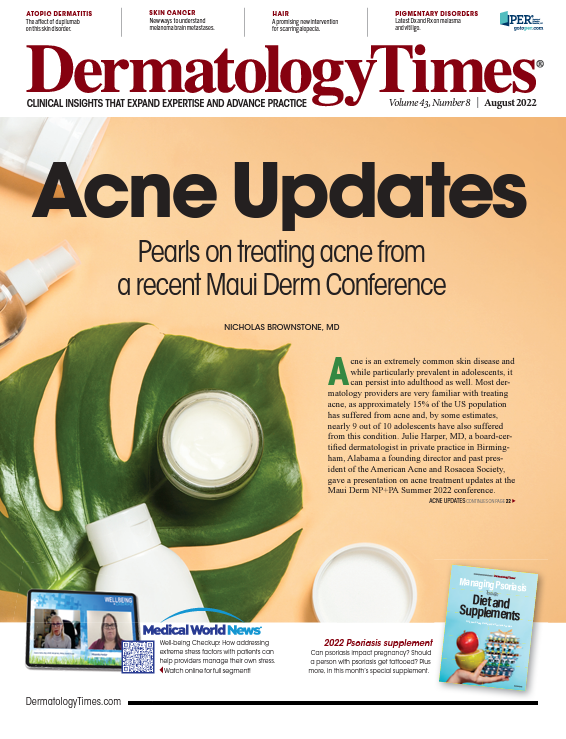- Case-Based Roundtable
- General Dermatology
- Eczema
- Chronic Hand Eczema
- Alopecia
- Aesthetics
- Vitiligo
- COVID-19
- Actinic Keratosis
- Precision Medicine and Biologics
- Rare Disease
- Wound Care
- Rosacea
- Psoriasis
- Psoriatic Arthritis
- Atopic Dermatitis
- Melasma
- NP and PA
- Skin Cancer
- Hidradenitis Suppurativa
- Drug Watch
- Pigmentary Disorders
- Acne
- Pediatric Dermatology
- Practice Management
- Prurigo Nodularis
- Buy-and-Bill
Publication
Article
Dermatology Times
Which Rosacea Treatment Protocol is the Best Fit for Your Patients?
Author(s):
In part two of her presentation at the 2022 SDPA Annual Summer Meeting, Shanna M. Miranti, MPAS, PA-C, discusses the best treatment regimen for your rosacea patients.
The treatment options for rosacea have expanded within the past few years Shanna M. Miranti, MPAS, PA-C, Riverchase Dermatology, Naples, Florida, details those new options and shares how to build the best treatment regimen for your rosacea patients during her presentation at the 2022 Society for Dermatology Physician Assistants Annual Summer Meeting held June 16-19, 2022, in Austin, Texas.1
Miranti began the talk by talking about how clinicians treat rosacea today. “We no longer categorize patients into 4 subtypes,” she said. Addressing the inflammation, redness, and textural changes should be the priority of the clinician treating their patient’s disease, as well as treating the flushing and bumps. Miranti also stressed the importance of recognizing rosacea symptoms in all skin types and advising patients about the chronicity of treatment.
Guidelines
The current guidelines classify patients into 3 phenotypes: diagnostic, major, and secondary. Diagnostic is characterized as fixed centrofacial erythema in a distinguishing pattern that may periodically intensity or a display of phymatous changes. Major is described as flushing, the presence of pustules and papules, telangiectasia, and ocular manifestations. Secondary is defined as a burning and/or stinging sensation, edema, dryness, and ocular manifestations.
Miranti also pointed out the fact that redness does not always appear “red”, especially in skin of color patients. “It is very important to recognize the inflammation of rosacea in our skin of color patients,” she stated.
What’s Approved?
Miranti also provided a list of current US Food and Drug Administration-approved treatments for rosacea. The first of which is a group of topical therapies, including:
- Metronidazole (0.75%, 0.1%)
- Azelaic Acid (Finacea Gel, Foam)
- Sodium sulfacetamide/sulfur
- Brimonidine (Mirvaso)*
- Ivermectin (Soolantra)*
- Oxymetazoline (Rhofade)*
- Minocycline 1.5% foam (Zilxi)*
- Benzoyl peroxide (Epsolay)*
*=Have been FDA-approved within the last 10 years.
However, there is only 1 systemic therapy FDA-approved for rosacea—Oracea 40mg (doxycycline).
Miranti mentioned there were multiple-therapeutic approaches to treating rosacea. This includes the topical treatment of papules and pustules, the use of topical vasoconstrictors, oral sub-antimicrobial dosed antibiotics, lasers and intense pulsed light devices (PDL), and cleansers/cosmeceuticals for rosacea-prone skin.
When it comes to PDL, Miranti says to advise patients that it will take multiple treatment sessions to see a significant improvement in disease. This treatment modality may require touch-up treatments, but patients can continue their current rosacea medications. Additionally, she added that clinicians may wish to engage these patients and start a prescription if they are not already on a rosacea regimen.
Overall, when it comes to developing a treatment regimen for rosacea, Miranti says that patients will be more compliant if they are involved in medical decision-making. Additionally, specialty pharmacies often get patients better pricing on medications and offer free delivery to their homes.
Disclosure
Miranti is a speaker for EPI Health, Galderma, Incyte, Ortho Dermatologics, Verrica, and Soarsa. Also, she is a consultant for Verrica and Soarsa, and an advisory board member for Galderma and Incyte.
Reference
1. Miranti S. Not your mama’s acne/rosacea regimens. Presented at: The Society for Dermatology Physician Assistants Annual Summer Meeting. June 16-19, 2022. Austin, Texas.







